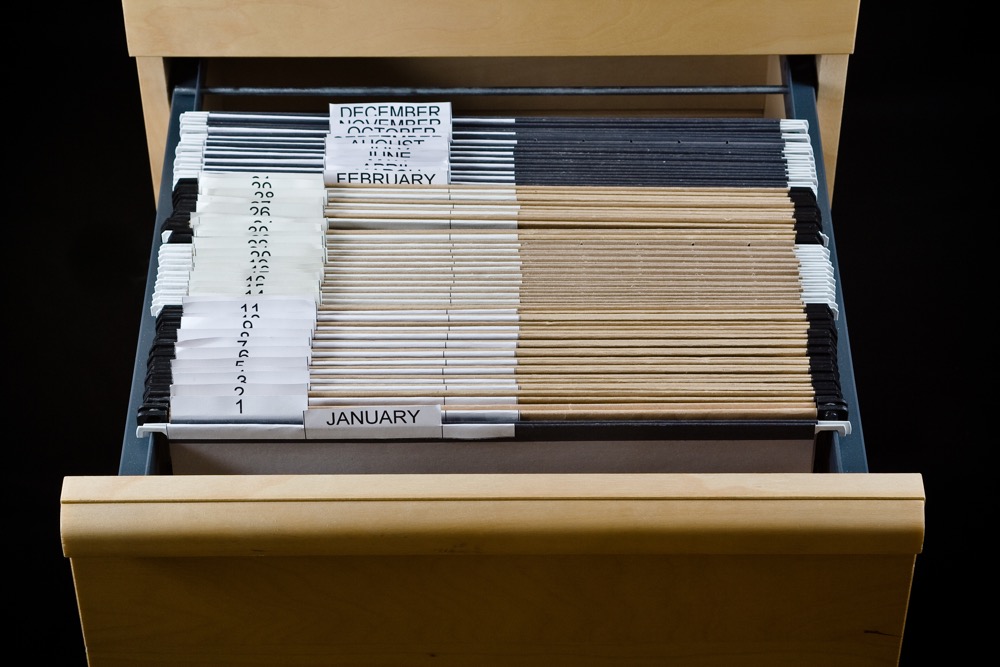Three-dimensional chess is a Star Trek staple. The board appears in several episodes, and you can buy your own replica courtesy of the Franklin Mint.
One of the novels takes the game a step further into the future with four-dimensional chess. Not only can you move your pieces in three-dimensional space, you can “rest” a piece, removing it from the board for a fixed number of turns, after which it returns to the board on its new square. This lets you set aside a piece that you don’t need now, and bring it back at just the right moment.
You can set up a similar system to reduce clutter, stop losing things, and increase your productivity. Take any piece of paper; set it aside for days, weeks, or months; and relax, confident that it will reappear on the exact day you need it. It’s like a time machine for your trusted system.
What You Need
To do this, you’ll need 43 folders: one folder for each month and 31 daily folders. Get a pack of sturdy folders—you’re going to be shuffling these around a lot, and you don’t want them to fall apart. Label them 1–31 and Jan–Dec.
You’ll also need a place to hang the folders. One of the drawers of my desk is sized for hanging file folders. Since I used non-hanging folders, I bought a file sorter rack, which fits in the drawer.
Initial Setup
If today were June 28, you would start with the folders in the following order:
- 29–31. You don’t need to put 28 first, since you aren’t going to send yourself anything for today. June only has 30 days, but keep 31 after 30. This way, you don’t have to think about where it goes, and you aren’t going to lose it.
- July. The folder for the next month comes next. If you get something today for July 29–31, it will go in this folder, since the daily folders for 29–31 currently represent June.
- 1–28. Next, put the rest of the daily folders. If you get something today for July 1–28, you can either file it straight to the proper daily folder, or you can toss it in the July folder and sort it to the daily later. Whichever will distract you less right now.
- August–June. Finally, place the rest of the monthly folders. June goes at the end because anything you get for the current month will go into the folder for that day.
What do you put in the folders?
Here are some ideas for what you can put in your time machine:
- Cards to sign
- Mobile-deposited checks waiting to be destroyed
- Bills that need paid
- The receipt from the library to take the books back
- A trigger to have our wedding rings cleaned
- A trigger to throw out warranty information
- A receipt for a purchase I’m going to return
- Dry-cleaning claim tickets
What about things that aren’t flat?
Some items won’t fit cleanly into a file folder, like our wedding rings. For tasks like this, take an index card and write the task on it: “Clean wedding rings”. The index card serves as a trigger—when the card comes up, it triggers a task for either myself or my wife to take them in. Once the task has been scheduled in OmniFocus or in her planner, the card goes back into the folders for the next cleaning.
The Daily Check
Every morning (or evening), when you plan your day, take out that day’s folder. Everything in it represents something you need to do today. Put it on your task list, schedule it on your calendar, or toss it in your inbox.
If today isn’t the right day, procrastinate it to another folder.
Empty folder? Great! You’re already done.
Now put the folder behind the last daily folder and in front of the next monthly folder.
The Monthly Rotation
On the last day of the month, it’s time to empty the next monthly folder.
Take it out. Everything in this folder is something that you scheduled to do this month. Move each item to the appropriate daily folder, then put the folder at the back.
Pro tip: Before adding an item to a monthly folder, write the final task date (“11/17”) on a small post-it note and stick it on the item. Most of the tasks I file have a specific date I need to process it, and having the date right there makes the monthly rotation a breeze. Thirty seconds and I’m done.
What about folders for the next five years?
I’ve considered doing this, but I don’t know that it would be worth it. The only practical use case I have for this would be to store a trigger to throw out warrantee information when it expires, say, three years from now. For something a couple years out, I’d just put the year on it and drop it in the monthly folder. During the monthly rotation, if it’s not this year, then just leave it in the folder.
Your Future Self Will Thank You
It only takes a few minutes to set up this kind of filing system, and it’s incrediby handy. No slips of paper cluttering about, hiding when you need them. No frenzied searches when you could be getting things done. Just 43 folders and the information you need, right when you need it.
Question: What could you put in your trusted system’s time machine? Share your thoughts in the comments, on Twitter, LinkedIn, or Facebook.

